- Bernard Preston homepage
- Bread
- Vegan Seed Bread
Vegan seed bread
Vegan seed bread is a high-fibre loaf which is rich in vitamins and minerals; so it's low GI. It is also relatively high in protein with added hummus; all the germ and bran are present in their normal ratios in true wholemeal.
Baking your loaf from basic principles is a time-consuming business, and frankly wasteful of
electrical energy. On the other hand, if you have unlimited space
in your day, there are few things more satisfying than kneading the
dough. Perhaps it's the reason why as a DC, I have enjoyed doing it for
so many years; but it takes hours.
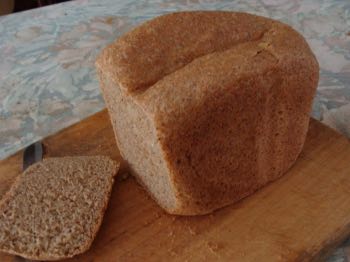
This page was last updated by Bernard Preston on 30th March, 2023.
Enter the bread-machine for our convenience; in just a few minutes you can prepare the ingredients and have everything ready. Five hours later you'll have a fine loaf made in the vegan tradition.
I use only one hundred percent wholemeal-flour; that you may have difficulty finding as those located on the shelf of your local store invariably have had more than a third of the goodness removed.
The reasons are varied but it has much to do with shelf-life; the oils in the wheat start to spoil once the grain is cracked.
My solution is to grind our own wheat; it's an expensive kitchen appliance and is only for those who are serious about baking and are going to use it regularly. The grain if bought in bulk has to be sealed and then frozen for ten days or the weevils will have a field day; and then stored in a cool room.
You will need a chest garage freezer that be dedicated to the grain for a few months.
For the greenie it could safely run on solar energy only; chilling during the day when the sun is shining. It's for foodstuffs that may defrost slightly at night with no problems; like wheat kernels.
Vegan seed bread
Vegan seed bread has added hummus to lower the glycemic index. In fact true wholegrain contains a relatively large amount of protein; but less after refining.
Firstly a short word on veganism; it means eating no product which came from an animal.
That means vegans eat no meat, dairy or eggs; including no butter. They have to be particularly careful to balance their proteins and a B12 deficiency can be a serious problem; it causes a serious, fatal disease called pernicious anaemia.
Probably the best butter-substitute is one made by Earth Balance, if you can find it. It's really a margarine but uses cold-pressed oils and contains no trans fat. Oils from the coconut and olive are the alternatives.
We mostly use coconut-butter in our vegan seed bread.
Ingredients
- Dry or wet yeast.
- 100% wholemeal wheat flour.
- Salt.
- Honey.
- Freshly-ground mixed seeds.
- Olive oil, Earth-balance margarine or coconut butter.
- Water.
Always twiddle the paddle before adding the ingredients; the gland tends to seize after long years of use and will destroy your bread-machine.
Traditionally sprinkle one and a half teaspoons of dried yeast in the bottom of your baking tin, making sure the paddle is in place; actually I'm getting better results by adding it on top of the dough.
Add the measured amount of flour according to your specific bread-machine.
Now prepare your seed mix. Add your chosen favourites to a simple coffee grinder and give it a good whizz. Many of them are poorly digested and pass through the alimentary canal unchanged unless they have been cracked.
A healthy mix might be flax and sesame seed to which today I've added half a dozen almonds; poppy, pumpkin and sunflower too.
You just use your favourites; we love pumpkin-seeds for their anti-inflammatory properties.
Not being able to use butter for shortening means you must find a source of oils from seeds or coconut.
I whizz up enough to last about a week and keep it chilled in the refrigerator. You could freeze it or prepare it every day; but then you won't finish your baking in five minutes.
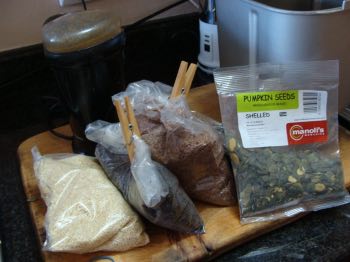
My apologies but the coffee grinder is very difficult to see against the black backdrop of the granite.
Return these packets to the freezer remember to prevent oxidation.
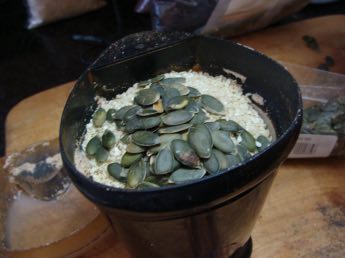
In the pound jar below you can visualise the ground-up seeds and nuts for your bread; that's what I keep in the fridge for a week or two.
The oils in the seeds make it quite sticky; wipe them out with your finger, making absolutely certain the blender is switched off.
It shouldn't start with the lid removed, but if there is an electrical-switch failure it could do massive damage to your hand.
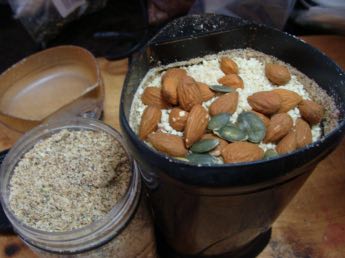
Toss a couple tablespoons of your ground seeds and nuts into the baking tin.
Add a teaspoon of sea-salt and enough honey to get the yeast fermenting.
Then you'll need a table spoon of olive oil or coconut butter and the measured amount of water, according to your machine recipe.
As an aside, let me say there's no point in using your special raw honey in bread; the heat from the baking will denature the important enzymes that are so unique.
Join the proverbial queen in her parlour and keep your raw honey for going on a slice of your vegan seed bread once it's baked; absolutely healthy and scrumptious. The glycemic index is low from all the added seeds and fat so you need not be concerned on that score.
Pop the oven dish in your bread machine and switch it on to the five-hour cycle. Anything shorter will not produce a decent texture.
It is a good moment to do a quick check. Is the paddle in place? Have you remembered the yeast and flour, salt, honey and water? And of course you haven't forgotten your mixture that makes your vegan seed bread unique.
Don't open the lid and peek; in four hours it will start to cook, smelling divine and be ready for lunch. If you are a greenie with a solar generator there will be ample energy coming in from the sun by noon to bake your delicious, nutritious loaf.
How much water?
There's a little compromise to consider when making your vegan seed bread. If you bake daily, then add a little less water for the perfectly risen loaf.
If you want it still to be moist on the second day, then add an extra tablespoon of water, but it may sink a little.
If you have a gluten intolerance, then consider making up a little of this sourdough bread recipe; it's a living creature that is full of the good bacteria that will help digest the offending proline-chains. That is the amino acid which gives some of us a bellyache, and allergies; it is resistant to digestion so short chains may unbroken.
Vegan seed bread receptacle
The better bread machines provide a receptacle for the seeds. If you add the ground seeds to the initial dough it inhibits the rising, and the loaf tends to either collapse or not rise properly.
Use your vegan seed bread receptacle for the ground-goodies; or add them at least an hour after starting.
In fact I'm experimenting with adding the seeds manually even later and getting better results; it does not rise as well.
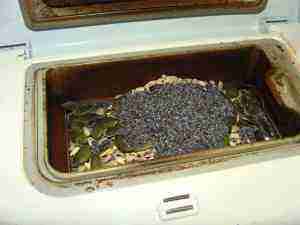
Low GI
Your vegan seed bread made from 100% wholemeal flour already has a moderately low GI, unlike the loaf from the supermarket. To lessen it still further, add a tablespoon of homemade hummus.
You don't know how to make hummus? That is a basic for everyone interested in wellness, but especially for vegans.
Once you have the ingredients you whizz this authentic hummus recipe up in just five minutes; I do it at least twice a week, and about half of it goes into our low GI bread. The hummus doesn't keep so you must use it within three day, and the balance in our home goes into the dough.
In seasons of carbs galore from the garden even good starches like this vegan seed bread need to be limited. It remains controversial but we think no one should have more than 150g of carbs per day; athletes excepted perhaps. And that is probably too much.
The net carbs in a true wholegrain bread are much lower. The fibre is not digested in the small intestine producing glucose; instead it is processed in the colon by the friendly flora forming very important short-chain fatty acids like butyrate.
Learning about resistant starch would be beneficial to everyone; enjoy your starches the day after baking.
Flax seed
Flax seed is one of my favourites as a DC. It's a powerful anti-inflammatory; so strong that there are reports of the oil spontaneously bursting into flame.
It's also known as linseed oil.
Vegan seed bread is not just for those who shun animal products; we can all enjoy and benefit from these foods.
Phytic acid
There are concerns in some circles about phytic acid binding the minerals in our vegan seed bread; certainly the artificially-added chemical does reduce calcium, iron and other minerals.
Consensus is that the naturally-occurring phytate is a very small problem as weighed against the enormous benefits of 100% wholemeal flour.
Interesting research now reveals that taking calcium supplements, even in the elderly and osteoporotic person is definitely not advisable. It is deposited in the inner lining of arteries making them stiff and increasing cardiovascular disease. So we must get the mineral from our food.
Research does show that vegans need to be careful of several deficiencies, in particularly B12, vitamin D and calcium; and omega-3 too[1].
For more information about "anti-inflammatory omega 3" and phytates, type these subjects into the Site Search function in the main menu bar above.
Update
I have finally accepted that vegan seed bread is better without the sunflower, flax and others; it is simply does not rise nearly as well, and the dough is much heavier.
Seeds are important; they are one of the few sources of vitamin E.
Vitamin E is one of the four very important nutrients that retard the start and progression of frailty syndrome. So instead, we now sprinkle them on our salad or on the whole grain porridge that we enjoy most days for breakfast.
A tablespoon of freshly-ground nuts and seeds always goes into our breakfast smoothies.
Life is full of small compromises; get your seeds and nuts in other ways. Do eat them daily.
Another good reason is the magnesium from nuts and seeds; without sufficient of this important mineral we would be certain to need blood pressure medication.
Choline
One simply huge advantage of your vegan seed bread made with 100% wholemeal flour is the B vitamin known as choline. The average Western diet has less than half the recommended amount. Deficiencies are involved in many very serious inflammatory diseases and birth-defects.
These wonderful choline food sources are just one more good reason to bake your own bread.
The vitamin E in 100 percent real flour will give an important extra benefit.
Honey
Some vegans won't eat honey; then you have to use sugar or the yeast will not thrive and your bread will be very heavy. They mistakenly think we exploit our bees.
Without commercial beekeeping there would be no almonds in America; none.
Red meat and diabetes
After following over 200,000 adults in the United States, scientists report a strong association between red meat consumption and Type 2 diabetes; starting 10 to 15 years later[3]. There was a 20% higher risk with every 50 grams increase.
Conversely replacing a serving of red meat with nuts or legumes lowered the risk by 30%.
Moderate use of dairy products also lowered the risk of becoming diabetic.
This is a very strong study taking many confounding factors such as BMI into account.
The risk was slightly lower for unprocessed red meat. There was no data concerning pasture-fed beef since it is not readily available to the general public.
When browsing use right click and "Open Link in New Tab" or you may get a bad gateway signal.
Newsletter
Our newsletter is entitled "create a cyan zone" at your home, preserving both yourself and Mother Earth for future generations; and your family too, of course. We promise not to spam you with daily emails promoting various products. You may get an occasional nudge to buy one of my books.
Here are the back issues.
- Investing in long-term health
- Diseases from plastic exposure
- Intensive lifestyle management for obesity has limited value
- A world largely devoid of Parkinson's Disease
- The impact of friendly bacteria in the tum on the prevention of cancer
- There's a hole in the bucket
- Everyone is talking about weight loss drugs
- Pull the sweet tooth
- If you suffer from heartburn plant a susu
- Refined maize meal and stunting
- Should agriculture and industry get priority for water and electricity?
- Nature is calling
- Mill your own flour
- Bake your own sourdough bread
- Microplastics from our water
- Alternative types of water storage
- Wear your clothes out
- Comfort foods
- Create a bee-friendly environment
- Go to bed slightly hungry
- Keep bees
- Blue zone folk are religious
- Reduce plastic waste
- Family is important
- What can go in compost?
- Grow broad beans for longevity
- Harvest and store sunshine
- Blue zone exercise
- Harvest and store your rainwater
- Create a cyan zone at your home
Did you find this page interesting? How about forwarding it to a friend, or book and food junkie? Better still, a social mead tick would help.
- Bernard Preston homepage
- Bread
- Vegan Seed Bread
Address:
56 Groenekloof Rd,
Hilton, KZN
South Africa
Website:
https://www.bernard-preston.com